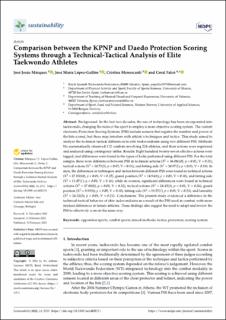| dc.identifier.citation | Márquez, J. J., López-Gullón, J. M., Menescardi, C., & Falcó, C. (2022). Comparison between the KPNP and Daedo Protection Scoring Systems through a Technical-Tactical Analysis of Elite Taekwondo Athletes. Sustainability, 14(4):2111. | en_US |
| dc.description.abstract | Background: In the last two decades, the use of technology has been incorporated into taekwondo, changing the rules of the sport to employ a more objective scoring system. The current electronic Protection Scoring Systems (PSS) include sensors that register the number and power of the hits scored, but these may interfere with athlete’s techniques and tactics. This study aimed to analyze the technical-tactical differences in elite taekwondoists using two different PSS. Methods: We systematically observed 112 combats involving 224 athletes, and their actions were registered and analyzed using contingency tables. Results: Eight hundred twenty-seven effective actions were tagged, and differences were found in the types of kicks performed using different PSS. For the total sample, there were differences between PSS in technical actions (X2 = 36.08(10); p < 0.01; V = 0.21), tactical actions (X2 = 10.73(3); p < 0.05; V = 0.11), and hitting side (X2 = 30.97(1); p < 0.01; V = 0.19). In men, the differences in techniques and tactics between different PSS were found in technical actions (X2 = 27.15(10); p < 0.01; V = 0.25), guard position (X2 = 14.94(1); p < 0.01; V = 0.18), and hitting side (X2 = 11.07(1); p < 0.01; V = 0.16), while in women, significant differences were found in technical actions (X2 = 37.03(8); p < 0.01; V = 0.32), tactical actions (X2 = 24.45(3); p < 0.01; V = 0.26), guard position (X2 = 3.95(1); p < 0.05; V = 0.10), hitting side (X2 = 19.27(1); p < 0.01; V = 0.23), and laterality (X2 = 16.32(3); p < 0.01; V = 0.21). Conclusions: The present study evidenced a difference in the technical-tactical behavior of elite taekwondoists as a result of the PSS used in combat, with more marked differences in female athletes. These findings also suggest the need to adapt and review the PSS to effectively score in the same way. | en_US |

